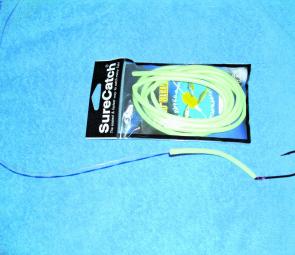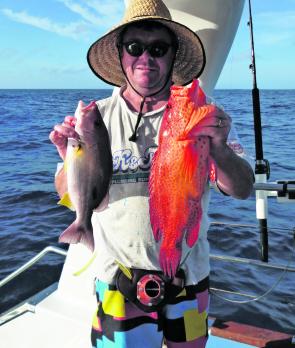The paternoster rig, aka double-dropper, snapper rig, or bottom basher, is known and used throughout the world. Most South East Queensland offshore anglers use the double dropper, or variations of it, for all of their bottom bashing and reef angling.
This simple yet effective back-to-basics rig is similar to versions of the drop-shot rig used by freshwater anglers. It allows hooks to be interchanged on the dropper loop in any one of the following scenarios - such as when a hook gets straightened, or if a hook goes blunt (especially when using chemically sharpened hooks), or if a different hook arrangement is desired like a big live bait hook, or 7/0 circle hook or a 5/0 gang rig swap over.
It also has a loop at the end of the trace that allows you to swap over sinker weights when you are using eyed leads such as snapper sinkers. The secret to improving your catch rate is to use just enough sinker weight to get to the bottom and hold when you let out a bit of line to make contact with the seabed again. This is the benefit of being able to quickly and efficiently change your rig's sinker.
I like the Sure Catch versions of the Aussie snapper lead because they sensibly have the weight moulded onto them.
I use up to 80lb braid as the main line for my bottom rig when I'm drifting; when you drift you can use the boat's movement to help you put pressure on the line and even break the line when you get snagged.
When at anchor it is hard to break 80lb braid, in fact you'll probably just pull the boat to the side a little. To avoid this I use 50lb braid for my mainline at anchor. I'm only a little girl (55kg) so even then it is still hard to break 50lb braid by myself when snagged and I have to ask for help.
Don't try to break the line through the rod or you'll risk breaking the rod.
There is much debate about the options for connecting the braided line (which is the most common main line on the reel these days) to the pre-tied monofilament dropper rig.
My Dad likes to have one of his outfits (or two) rigged with a snap-swivel. The snap makes it easy to connect on either a live bait rig (the livie rig will either have a swivel or ring at the top), a wire leadered trolling lure (either skirted, a feather, or hardbody), or wire-leadered live mackerel bait. This rod is a long rod such as a Live Fibre M10. The longer length of the rod allows the snap-swivel to sit at the rod tip and the leader length is crafted so that the hooks fit into the harness lug eyes on top of the reel frame. Thus the rig is secured and doesn't swing dangerously around. At times this outfit's snap may get fastened to a dropper rig.
The other outfits see the dropper rig connected to the braid by an improved albright knot (other knots will also work well). Dad ties his braid straight to the dropper leader using his version of the albright. I tie a double using a bimini twist then I tie an albright with the double line. Ideally my bimini knot sits very close, almost hard up, to the albright knot.
Many crews use swivels as the connecting link, but some dislike any hardware at all because they make tangles harder to untie without cutting. When cutting to untangle a bunch of grapes between two or more lines I use braid scissors rather than wielding around a sharp knife.
Using the albright knot instead of the swivel means that you effectively have a wind-on leader system and this helps with storage, especially if you remove the hooks and sinker. Also if your length of mono is long enough you can use it to retie once without having to retie the albright knot – I guess it depends which knot(s) you prefer to tie.
Likewise, you can also have your reel(s) spooled up, albright tied, droppers tied and sinker loop tied so that you are ready to go when you get to the spot. Just put your reel on the rod and thread the dropper set-up up through the guides, but don't choose a rod with small guides. I especially dislike those horrid skinny minny roller tip guides that you may see on old rods like some of the 1980's Snyderglas jig rods. If you have one of these get the tip guide changed – in fact there is no need for a roller tip at all, so go for a large ring guide for your tip guide.
There are at least four dropper knot options: the standard dropper knot (aka knotless knot); the twisted dropper; and believe it or not, the spider hitch. You can also tie the overhand knot (triple or quadruple pass) which I think is also called the Surgeon's End Loop.
• The spider hitch has a breaking strain of around 80% when tied with five loops around the thumb/forefinger.
• The dropper knot has a breaking strain of around 80% of the main line.
• Droppers should be spaced so that they do not overlap; and so that the hooks (including gangs) do not overlap either.
• Droppers should be at least longer than the largest hook that you wish to use.
• Droppers tied using he standard dropper knot will stand out from the main line better than loops formed with the spider hitch.
• It is easier to tie short droppers with the dropper knot than it is with the spider hitch. I like one of my droppers to be short (around 15cm) and the other about 30cm long. Sometimes I'll go much longer to 60cm for times such as when I’m at anchor.
• If your droppers are 12-15cm long then they should be at least 50cm apart – that's with one single 5/0 chemically sharpened hook on the bottom and a two-hook gang rig on the top dropper.
• Twisted droppers loops are stiffer and can help the hook hang away from the dropper line.
• A strip of lumo tube on the dropper can assist in reducing tangles as well as performing its promoted role of attracting fish. Make sure your chosen tube is of large enough diameter to allow double twisted 80lb line to pass easily through it.
• Many reef charter boats avoid the three-way swivel because when two or more lines get tangled with each other then it can be impossible to work around the swivels. Thus everything gets cut and re-tied every time.
There are two options for tying the loop off at the end of the dropper: the figure of eight knot (blood bight knot) or the overhand loop.
The suggested preference is to use the figure-of-eight knot tied with doubled line; just make a loop and tie a figure-of-eight using the loop. This knot has a low strength, about 40-50% only. So should your sinker get snagged then it is likely that the knot will break when you put on maximum pressure. Hopefully you’ll get your hooks back, although you will have to retie a new dropper.
I like to have the sinker 80-100cm below the first hook. However if I'm targeting smaller fish I'll reduce that distance and put a 5/0 red tarpon on as the bottom hook about 30cm above the sinker.
You can also tie a sinker to a loop of lighter line and loop it into the sinker loop. This has the advantage that when it breaks, hopefully you won't have to retie any of your dropper rig.
Note that your figure-of-eight knot most likely won't go through the eye of all of your snapper leads. Tie the loop so that it is longer than your longer sinkers. This enables you to pass the loop over them.
If you don't have enough line left to do this or if you have just had a bust off for example, then consider using another piece of line (often a lighter line is the go for this extension). Tie loops in this extension piece at both ends, one loop being for the sinker and one to loop into the short loop that you've tied on at the end of your dropper rig.
Most dropper rigs are tied from 50-80lb mono for rod and reel angling. I pre-tie a batch in a variety of breaking strains before each day trip. I take spools of extra leader on longer range trips of three days to a week. Make sure the line that you use for the leader is super abrasive resistant.
Beware, double 80lb (i.e. the loop of 80lb line) will only just pass through the eyes of some 5/0 hooks and not through others. Therefore if you need to drop down to 5/0 hooks (some prefer ganged 5/0s, others prefer single 7/0s) then you have four options:-
1. Use a fine, thin diameter, 80lb leader.
2. Check out your hooks and go for ones with a big eye . Make sure that it is a smooth eye, rough eyes will cut your line and loose you that trophy red emperor of the trip.
3. Use 60lb leader.
4. Tie a dropshot rig using the palomar knot. This gives you a single line with which to tie to the hook's smaller eye. The hook must be tied on before the sinker loop is made.
One of the reasons for using genuine live bait orientated hooks is that you can use much larger leaders because of the bigger eye on the hook – I'll go up to 200lb game leader with the deep 'V' or circle hooks.
I learned how to put a hook on the dropper as a youngster, and it always seems logical to me if I remember it in the way that I'm about to explain.
If you tie a hook on a line and slowly pull it through the water the hook will ride point upwards. The gape of the hook, the bend if you like, acts as a keel. When putting a hook on a dropper you don't want to fight this natural tendency. So feed the dropper loop down into and through the eye of the hook from the point side of the hook.
Then thread the eye up the dropper loop, pass the end of the loop over the pointy end of the hook and pull tight so that the end of the dropper loop snugs down around the eye. This process sets the minimum length for a dropper loop i.e. the dropper loop must be longer than your hook.
Next month I’ll be looking at hooks and gang choices for your dropper rigs.
Reads: 20035
The paternoster, or dropper rig, with the hook on a dropper and sinker looped to the end sees popular use amongst reef anglers, like for this beautifully coloured Hervey Bay caught Venus tusk fish.

The twisted dropper with lumo tube is arguably the most elaborate set-up for the bottom basher rig, yet it is still very simple to master and tie when out on the water. A handy tip to use a dampened old towel as your non-slip surface when rigging up at se

The sinker loop and snapper sinker. The loop makes it easy to change out your 'plumb bob' for a lighter or heavier sinker should the depth/current/ wind (or all three) change during your fishing trip. The sinker at the top of the photo is a bank sinker, t

A double dropper rig will sometimes produce a fish on each hook; in this case a Moses perch and a cod.




